Congress is significantly underfunded — especially compared to the executive branch — and it has suffered deep staff cuts over the last 25 years. In March and in September, we co-authored letters naming the fact that not only does the Legislative Branch receive the smallest funding level of the 12 appropriations subcommittees, it has received funding cuts (in real terms) over the last decade even as other appropriations subcommittees have received increases.
As we speak, the House and Senate are negotiating over how much in new funding to give to each of the 12 appropriations subcommittees. In play is how to divvy up a significant increase in overall funding: a $27 billion increase in non-defense discretionary spending over the next fiscal year.
According to CRS, in FY 2019 the legislative branch was funded at $4.836 billion. How does the proposed increases in Leg Branch funding from the House and Senate compare to last year’s funding level?

Continue reading “Appropriators Should Provide Adequate Funding to Congress”

